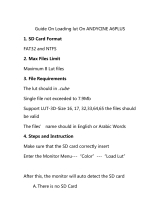
3
Applying a LUT to Video Outputs
While recording using special gamma curves, you can apply a LUT to the image displayed on external monitors
(SDI OUT terminal, MON. terminal, HDMI OUT terminal), the supplied LCD screen (VIDEO terminal) or an optional
viewfinder. When a LUT is applied, the displayed image will look as if a standard gamma curve were used,
making it easier to check the image on the display device used. To check the image on an external monitor, you
will need a monitor that is compatible with the video’s color space.
You can also load and apply LUT files (.cube format) created with Blackmagic Design’s DaVinci Resolve.
Available preset LUT options
Available LUTs depend on the [Gamma/Color Space] setting in the custom picture file.
1
Not available for the VIDEO terminal (supplied LCD monitor/optional LV-M1 LCD Monitor/optional EVF-V70 OLED Electronic
Viewfinder).
2
Available only for the VIDEO terminal (supplied LCD monitor/optional LV-M1 LCD Monitor/optional EVF-V70 OLED Electronic
Viewfinder).
3
When [Gamma/Color Space] is [HLG / BT.2020], only the [HDR Assist. (400%)] LUT is available.
1 To apply the LUT to the supplied LCD screen, select > [
¢
Monitoring Setup] > [LUT: VIDEO
Term.] > [On].
2 Select > [
¢
Monitoring Setup] > [LUT Selection: VIDEO Term.] > Desired LUT.
• The gamma curve and color space of the video output will change.
• Repeat steps 1 and 2 as necessary to apply LUTs to other video outputs with the following settings:
[LUT: SDI OUT] and [LUT Selection: SDI OUT]: video output from the SDI OUT terminal,
[LUT: MON.] and [LUT Selection: MON.]: external monitor connected to the MON. terminal,
[LUT: HDMI] and [LUT Selection: HDMI]: external monitor connected to the HDMI OUT terminal,
[LUT: EVF-V50] and [LUT Selection: EVF-V50]: optional viewfinder.
[Gamma/Color Space]
Available LUTs
[BT.709] [BT.2020]
1
[DCI]
1
[PQ]
1
/
[HLG]
1
[ACESproxy]
1
[HDR Assist.]
2
(1600%/400%)
[Canon Log 2 / C.Gamut],
[Canon Log 3 / C.Gamut]
Ü Ü Ü Ü Ü Ü
[Canon Log 3 / BT.2020] Ü Ü – Ü – Ü
[Canon Log 3 / BT.709] Ü – – – – –
[PQ / BT.2020],
[HLG / BT.2020]
Ü – – – – Ü
3
[BT.709 Wide DR / BT.2020] Ü – – – – –
[BT.709 Wide DR / BT.709],
[BT.709 Normal / BT.2020],
[BT.709 Normal / BT.709]
– – – – – –




